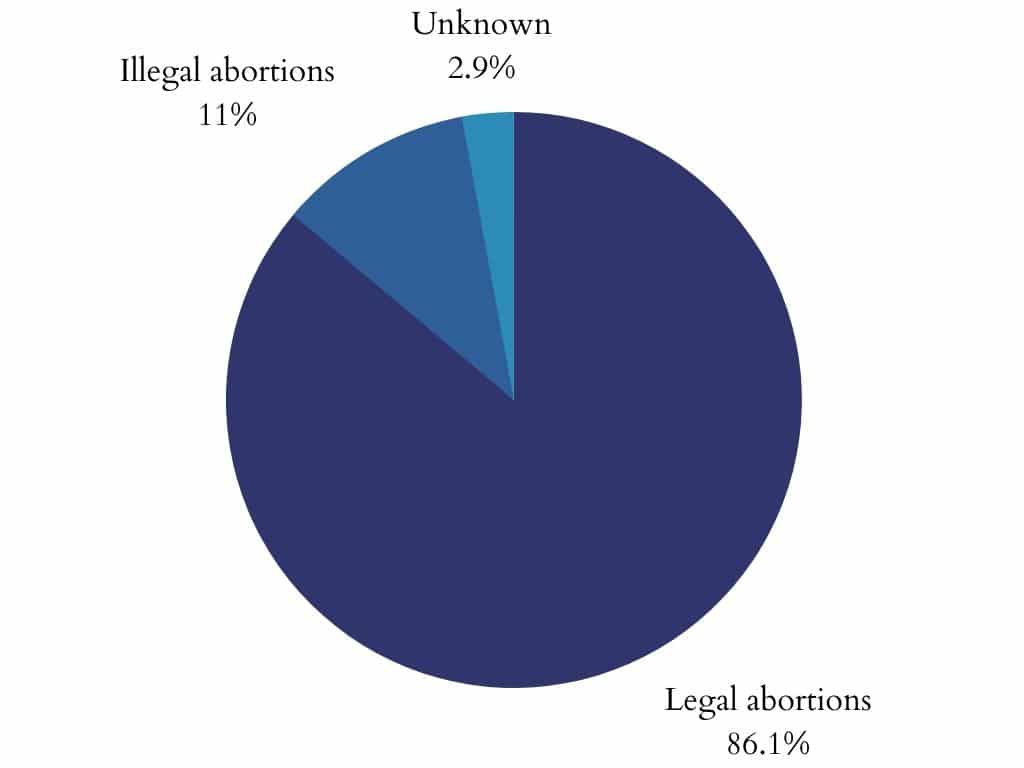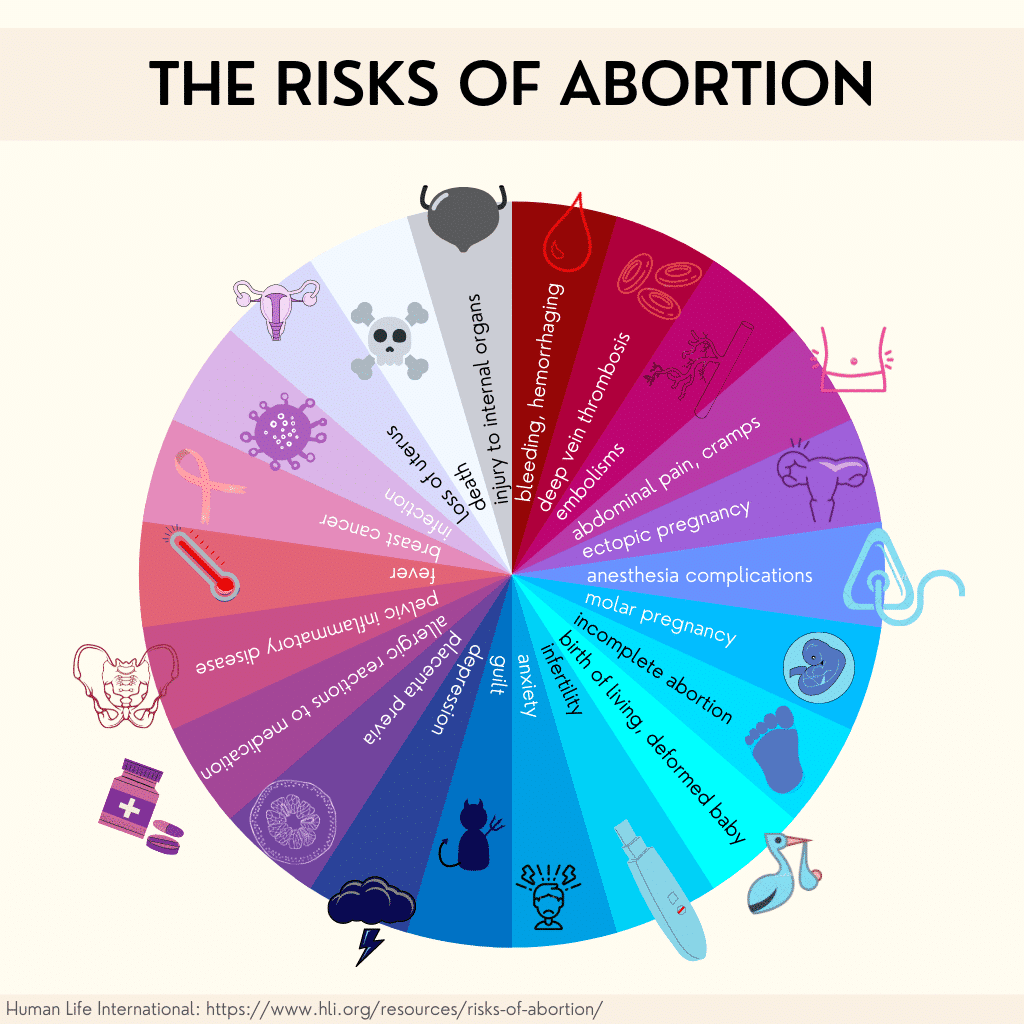The pro-abortion movement has gone to great lengths to downplay the risks of abortion to the mother, but these risks are very real. This article will examine some of the common consequences of abortion. As we shall see, aside from always resulting in a dead baby, abortions are also dangerous to the mother.
Injuries to Women
We have all heard abortion stories—like Abby Johnson’s—of women given little-to-no aid after their abortions. In his book Abortion Practices, prolific late-term abortionist Dr. Warren Hern once admitted: “In medical practice, there are few surgical procedures given so little attention and so underrated in its potential hazards as abortion. It is a commonly held view that complications are inevitable.”1

Not much has changed since his admission. Women are often injured, as Operation Rescue repeatedly documents. And women still suffer both short-term and long-term effects. In a 2019 amicus curiae brief, former abortion providers Dr. Kathi Aultman, Carol Everett, Dr. Anthony Levatino, and Dr. Beverly McMillan testified in Louisiana to the need for abortion doctors to have hospital admitting privileges. They testified because they understand the frequent dangers to the mothers—dangers that are exacerbated when the abortionist cannot or will not send mothers to the hospital after something has gone wrong.
According to the brief:
Reliable scientific and medical studies confirm the physical and psychological risks of abortion. In the largest government study, the Report of the South Dakota Task Force reviewed the scientific studies and heard testimony from medical experts and post-abortive women. The Task Force concluded that there are serious physical and psychological consequences of abortion and women should be protected.
The brief goes on to cite the evidence from the task force:
In creating the Task Force, the Legislature recognized that “there exists a need for special protection of the rights of such pregnant women, and that the State of South Dakota has a compelling interest in providing such protection.” After hearing evidence from medical experts and post-abortive women, the Task Force stated:
The record reflects that abortion places women at increased risk of physical injury including the risk of: infection, fever, abdominal pain and cramping, bleeding, hemorrhage, blood transfusion with its subsequent risks, deep vein thrombosis, pulmonary or amniotic fluid embolism, injury to the cervix, vagina, uterus, Fallopian tubes and ovaries, bowel, bladder, and other internal organs, anesthesia complications (which are higher with general anesthesia), failure to remove all the contents of the uterus (leaving behind parts of the fetus/baby or placenta), need to repeat the surgery, possible hospitalization, risk of more surgery such as laparoscopy or exploratory laparotomy, possible hysterectomy (loss of the uterus and subsequent infertility), allergic reactions to medicines, mis-diagnosis of an intrauterine pregnancy with a tubal or abdominal pregnancy being present (which necessitates different treatment with medicines or more extensive surgery), possible molar pregnancy with the need for further treatment, emotional reactions (including but not limited to depression, guilt, relief, anxiety, 5 Id. at 5. 6 etc.) death of the woman, and risk of a living, injured baby.
In addition, the Task Force heard evidence that there are long-term consequences of abortion including that abortion places women at increased risk of other long-term physical injury including placenta previa which necessitates a c-section and has higher rates of complications and pre-term birth in subsequent pregnancies.
In addition to the risks to the health of the mother, there is also the risk of death. According to Raymond Adamek, who has researched and written about this subject:
The most recent (November 27, 2020) Abortion Surveillance report by the CDC, covering 45 years from 1973 through 2018, indicates that, out of 519 maternal deaths, 86.1% resulted from legal abortion, 11% from illegal abortion, and 2.9% from abortions whose legal status was unknown.
Maternal Deaths from Abortion, 1973 – 2017

Hence, on average, legal abortion accounted for almost 10 maternal deaths per year, which might suggest that legal abortion is quite “safe,” given the number of annual abortions performed. However, we should note that not all states give information about abortions to the CDC. A 10-year review (2007 through 2016) of CDC reports indicates that California, Maryland, and New Hampshire did not report. The current CDC report says that, according to the Guttmacher Institute, in 2017, these three states saw 19% of the nation’s abortions. Furthermore, the CDC has noted that its annual reports only include 68-71% of the abortions reported by Guttmacher’s survey of clinics.
Aside from these flaws in recording, we also see other factors that come into play regarding why we have difficulty getting accurate statistics about abortion-related injuries.
For instance, abortion clinics give women the option of seeing their primary doctor for the follow-up visit. Whether this is for the comfort of the women or for the convenience of the abortion industry is open to interpretation, but the result is that many injuries are unreported or are reported as something else. Further, women who suffer complications rarely return to the abortion clinic but go to the emergency room. This is especially common when a woman has taken an abortion pill. In this case, she may present herself as suffering from a miscarriage. In addition, when women do suffer complications from botched abortions—or die—their injuries or deaths are often attributed to other causes, especially since many women want to keep their abortions secret.
What Are the Risks of Abortion?
The risks of abortion are many. Besides the women who die each year from legal abortions, many women suffer other injuries—both physical and psychological. And though the reported number of women who die may be “small,” even one death is too many. So let’s examine the risks:
Pelvic Inflammatory Disease
PID is life-threatening and can lead to subsequent infertility and an increased risk of ectopic pregnancy. The long-term effects of PID can be devastating for the woman. Further, PID can permanently damage and scar the fallopian tubes, or even cause blockage of the tubes. If a woman has an STD at the time of her abortion, her risks for PID are even greater. According to a 2020 Pregnancy Care Clinic article, “If you have untreated chlamydia or gonorrhea, you’re up to 23% more likely to develop PID after an abortion. The reason this happens is that bacteria from outside your body can be transmitted into your reproductive tract.”
Placenta Previa
Placenta previa happens when the placenta becomes superimposed on the cervix and causes severe hemorrhage during labor. A 2017 article examining this condition has found a “significant association” between induced abortions and placenta previa. In 2006, the Catholic News Agency solicited two obstetricians and a family practice doctor to prepare a list of complications following abortion. According to this report: “Several studies analyzed in a landmark 2003 article in the Obstetrical and Gynecological Survey show that induced abortion also increases the risk of placenta previa by 50%.” The CNA further reports: “Placenta previa occurs 6 to 15 times more often after a woman has had an abortion.”
Ectopic Pregnancies
Abortion is also related to an increase in ectopic pregnancies in future pregnancies, which can seriously threaten the mother’s future fertility and even her life. The Catholic News Agency report referenced above states that “statistics show a 30% increased risk of ectopic pregnancy after one abortion and a 160% increased risk of ectopic pregnancy after two or more abortions.”
Cervical Lacerations
Cervical lacerations, or tears in the cervix, are said to occur in three percent of second-trimester abortions. Less severe undiagnosed cervical damage may result in subsequent cervical incompetence, premature delivery, and labor complications. Cervical damage and scarring of the endometrium from abortion may also increase the risk of abnormal development of the placenta in subsequent pregnancies, thus increasing the risk of birth defects.
Uterine Perforation
Between 0.1 and 3.0 per 1,000 of aborting women suffer perforations of the uterus during a vacuum aspiration abortion. Sadly, most of the perforations caused during first trimester abortions go undiagnosed. These injuries could lead to future problems that may require a hysterectomy or other major corrective surgery. Perforations occurring during late-term abortions are more frequent and always serious in nature.
Breast Cancer
The risk of breast cancer after abortion has been hotly debated for many years. Some studies claim there is no risk, while others have found a correlation. As the American Cancer Society explains, the different results come from the different ways the studies were conducted.
![]()
According to AbortionBreastCancer.com, research has shown “a statistically significant 40% risk increase [of breast cancer] for women who have had abortions.” CompassCare is a nonprofit healthcare center in New York. In an effort to be forthright regarding the risks of abortion, its site lists several short-term and long-term side effects. One such note addresses the breast cancer link and says: “Studies show that abortion increases a woman’s risk of breast cancer. A 2013 analysis revealed a 44% increased risk of breast cancer among females who had at least one induced abortion. The relative risk increased to 76% and 89% for those who had at least two or three abortions, respectively.”
Infertility and Future Childbearing
Having an abortion puts the mother at risk in subsequent pregnancies or may even leave her infertile. According to CompassCare:
First-trimester surgical abortion by dilation and curettage (D&C) “can result in uterine synechiae (or Asherman’s Syndrome), which increase the risk of subsequent midtrimester spontaneous abortions and low birthweight deliveries.” Incompetent cervix is also a preterm birth risk associated with surgical abortion. “Symptoms related to cervical incompetence were found among 75% of women who undergo forced dilation for abortion.”
The site goes on to say that the woman most at-risk for these complications include women who smoke heavily; have an IUD; have uncontrolled high blood pressure; have heart, liver, or kidney diseases; or who take certain steroids or blood thinners.
Psychological Risks
In addition to these physical risks, abortion also entails great psychological risks to women. Many women suffer from Post-Abortion Syndrome, which is a type of PTSD. The Pregnancy Care Center has found that women who have had abortions feel guilt and anxiety, have suicidal thoughts, feel numb, develop eating disorders, abuse alcohol and drugs, resort to sexual promiscuity, and find themselves unable to bond with future children.
These findings are consistent with what the staff at the Living Well Medical Clinic have found, though they refer to it as Post-Abortion Stress Syndrome. The Living Well Medical Clinic is a national helpline for abortion recovery, and according to its site, its staff members have seen “thousands of women who are traumatized from their abortion experience.”

C. Everett Koop
Whether called Post-Abortion Syndrome or Post-Abortion Stress Syndrome, this serious and heartbreaking condition is real. Yet it has been strongly denied by the pro-abortion movement for years. In the 1980s, NARAL Pro-Choice America claimed that no evidence was found for this syndrome by Surgeon General C. Everett Koop when he was assigned by President Reagan to study it in 1987. And despite all the evidence to the contrary, these pro-aborts still make this claim today.
However, even then, Koop was enraged at this twisting of his words, telling an interviewer:
Instead of saying “the Surgeon General could not find sufficient evidence to issue a scientifically statistically accurate report that could not be assailed,” the Associated Press said, “He could find no evidence.” I know there are detrimental effects [from abortion]. I have counseled women with this problem over the last fifteen years. There is no doubt about it.2
According to Rachel’s Vineyard, Koop went on to say that the studies were flawed because they didn’t examine the respondents long enough. He recommended that more money be spent on longitudinal studies to obtain accurate results.
Indeed, we know that regret often takes years to surface. According to a recent HLI article:
Despite a new study that claims that women feel relief five years after having an abortion, this is not what pro-lifers working in the field see. They see an increase in the number of church groups and other post-abortive ministries. They see an increase in the number of people seeking counseling after an abortion. And they see women seeking counseling 10 or even 20 years after an abortion. Regret can happen any time, and women need help healing.
Again, we see that, in order to find truly accurate results, studies must follow post-abortive women for a longer period of time. Five years is not long enough to study women’s behaviors and emotions to determine how they will feel, especially as many are still young and have not yet realized or understood the gravity of their actions.
Healing and Forgiveness
But, when women (or men) do want help, healing is possible. Many organizations exist that can help post-abortive men and women heal. One such organization is Rachel’s Vineyard. Its staff understand the real trauma behind abortion. They have heard stories of women traumatized by the sound of a vacuum because it sounds like the vacuum used in the abortion. They know that women dull their pain with alcohol or drugs. They understand that some women cannot see children without breaking down in tears because they are constantly reminded of the baby they aborted.
They know all this, and they want to help those who are suffering. They encourage these men and women to ask God for forgiveness. And they teach them to learn to forgive themselves. Without this forgiveness, there cannot be healing. And God’s mercy blankets those who ask for forgiveness.
If you are feeling regret after an abortion, you can find help at Rachel’s Vineyard or in the first chapter of HLI’s Facts of Life book.
+ Endnotes
[1] Warren Hern. Abortion Practice [Philadelphia: J.B. Lippincott Company], 1990, pages 101 and 103.
[2] Dr. C. Everett Koop. Interview with the Rutherford Institute, Spring 1989. Also recounted in The Abortion Injury Report (a publication of the American Rights Coalition, PO Box 487, Chattanooga, Tennessee 37401). Spring 1990, page 2.
HLI staff writers bring you stories from the mission field and the latest information on life and family issues. All HLI articles are true to Catholic teaching.







